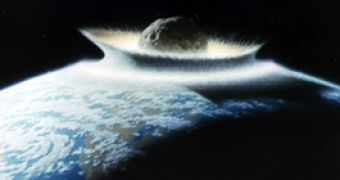Several movies have been made during the years depicting the potential catastrophic consequences of an asteroid or a comet intersecting Earth's orbit, and smashing onto its surface, or potential deflection strategies to avoid such a scenario.
There are a lot of NEOs or Near Earth Objects, in the planet's orbit, or periodically coming close by. But the scenario involving a large asteroid hitting the Earth is highly unlikely, since there are not that many large asteroids in the near vicinity of our planet. In its early life, Earth was virtually bombarded with millions of celestial bodies, ranging from small meteorites to large asteroids, or possibly a planet. In fact, scientists believe that Earth crosses path with a smaller planet in its infancy, since they cannot explain why we have such a large moon, blasting both apart. Most of the material thrown into space, was gathered by the gravitational field to form Earth, and the remaining debris orbiting the planet formed our large Moon.
Senior lecturer in astronomy and astrophysics at Penn State, Chris Palma, says that the probability of such an event happening is relatively high. We know that it happened in the past, it will happen in the future as well, it's just a matter of time. Though two years ago, a law that required NASA to both survey the near Earth objects, and come up with a plan to divert them, critics say that neither the US government, nor NASA have done enough to prevent these potential events.
In 1908, in Siberia, Tunguska, a large scale meteorite hit the Earth, triggering an explosion a thousand time more powerful than the atomic bomb dropped on Hiroshima, flattening 830 square miles of forest. Such a meteorite hitting a heavily populated area would claim thousands of lives, and destroy large parts of the infrastructure in the impact region.
NASA's NEO and the University of Arizona SpaceWatch group, have been systematically searching the sky for objects in the proximity or orbiting the planet, to predict and monitor threats posed by meteorite and asteroid impacts. Recently, the US government has withdrawn the funding for a number of missions, associated with the Near Earth Objects program, because NASA has failed to expand its search for objects smaller than 140 meters.
There are so far no practical plans if an asteroid will be detected on a path heading towards Earth. Several ideas have been proposed, such as sending a massive spacecraft toward the asteroid to redirect its path, by using the ships gravitational field. The idea is theoretically and physically possible, but the technology today does not yet allow us to move massive objects into space.
Although NASA says there is no immediate threat for a large object to hit Earth, there are still uncharted objects that could produce extensive regional damage if they would hit the planet. Unfortunately, not enough measures have been taken so far to prepare for such potential disaster.

 14 DAY TRIAL //
14 DAY TRIAL //